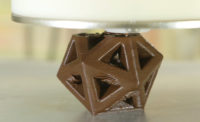Food and technology have always been integrated — but the future of food as we know it could be shifting in dramatic ways, according to futurist Mike Walsh, ceo, Tomorrow, a global consulting firm.
At this year’s recently held IFT Food Expo in Chicago, Walsh, author of Futuretainment and The Dictionary of Dangerous Ideas, delivered the keynote address about the future of food.
“Food is culture and touches the human experience,” says Walsh. And the cultural norms surrounding food are changing as much as the technology behind it.
The first take-home point of Walsh’s message is that technology affects the way consumers eat.
For instance, the popular tendency to take pictures of a meal before eating it.
This trend started showing up after the introduction of the iPhone in 2007, which Walsh argues was a major turning point.
As a result, “There’s a new subculture of food styling,” Walsh points out.
And having smartphones always at the ready during meals has even affected restaurant sales.
After examining metadata, one restaurant realized that the average meal lasted 1 hour in 2004 — and stretched to two hours by 2014. Customers were taking pictures of their food for so long that they were sending food back to be reheated, therefore ordering less overall.
But technology doesn’t just affect how people are eating — it has and will continue to change what they eat.
Walsh stresses that by 2050, scientists believe that there will be 9.6 billion people on earth. And all those people will require a 50-70 percent increase in food production in order to feed everyone. Moreover, people are going to want meat — or at least protein, he says.
This is where innovation can take the form of genetic engineering and alternatives to protein.
For example, Beyond Meat, a company that envisions a future where plant protein will completely replace meat protein, has developed a burger using pea protein.
And, Jungle Bar, a protein bar featuring cricket powder, is currently featured on Kickstarter by Crowbar Protein. It turns out insects can contain as much as 65 percent protein, versus lean beef and lamb at 35 percent.
While these trends might leave some consumers wary, what’s causing the real controversy is the genetic engineering of meat.
Walsh points out that Belgian blue cattle are genetically engineered to have a higher lean muscle mass, resulting in more tender meat. This is possible due to selective breeding, which some people fear is too similar to GMOs.
“How do you innovate when regulators want you to stop and ask permission?” Walsh challenged the audience.
Given the fear behind “editing” produce and living organisms, consumers may want such products to be classified as GMOs in the future.
Controversy also surrounds Soylent, the odorless, colorless drink which contains enough calories and vitamins to meet daily needs.
The project, started by Robert Rhinehart, has already made $20 million. Walsh believes that some consumers have decision fatigue — and that the idea of drinking Soylent rather than cooking can be a cheap, attractive, even stylish way to dine.
But alongside the controversy comes exciting innovations in what food will be like in the future.
“The future isn’t simply an upgrade on the present — it is an invitation to think in an entirely different way,” says Walsh.
That new way can take the forms such as the Foodini, a 3-D food printer from Natural Machines. To the future generation, even food will be a digital product, Walsh says.
And the future generation is everything. While data is important, Walsh stresses that innovators should start with the people they live with — particularly eight-year-olds and under.
They were the first group to never know a world without a smartphone, and will therefore see the world differently and become different consumers.
“Ask your children what they think the future of food will be,” suggests Walsh.
And finally, Walsh challenges companies to look at metadata. With increasing amounts of data available — spurred by the falling cost of drones and micro-satellites — companies will be able to pick up visual patterns, such as how many cars are parked in a lot.
After all, in Japan a robot named Pepper collects data from store guests and sends it to a cloud.
As Walsh concludes, “think big, think new, think quick — the future is now”.





